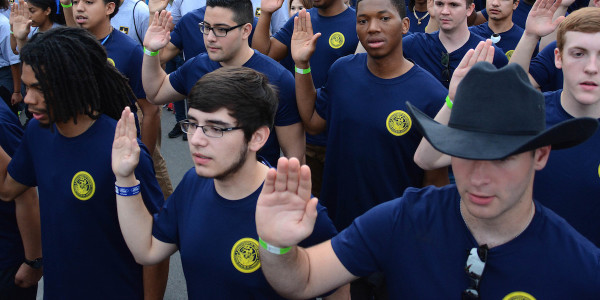

Military recruiting is growing more difficult by the day,andmany lay the blame squarely at the feet of the Millennial generation. But is this actually fair, or is it time for the military to rethink its hiring practices?
Time after time, surveys show that millennials want to pursue purposes larger than themselves. Yet by and large, they don’t join the military. They may want purpose, but they also like freedom. They’re a job-hopping generation as well. The current structure of military contracts — at least two-years in length, though most commitments run at least four years — doesn’t suit their life plans.
The military has two choices: It can sit around and complain about how millennials don’t want to serve, or it can adjust to the times. We haven’t heard much about the “Force of the Future” since the Trump administration took office, but the societal and technological forces behind that initiative remain.
Whether it happens right away or not, the nature of military service is going to change. The traditional model — successive four-year enlistments until hitting 20 or more years of service — won’t be the norm for much longer. Recent changes to the military retirement system already point toward that future.
The Australian Defense Force has boldly tried an idea the United States has so far shied away from: one-year enlistments designed to fit into a new graduate’s gap year. The ADF offers a number of one-year enlistments for a limited number of military specialties to high school graduates under 24. After that year, enrollees are left with three options: apply for an active-duty re-enlistment, join the reserves, or simply walk away.
Aussies aren’t the only ones fond of taking a year off. Gap years are increasingly popular in the United States; and the standard for young people across European countries. Some students use the time for volunteer work, others work as missionaries, and some just go out and see the world. Gap years are generally a good thing, giving young people with important life experience and an added layer of maturity before they head off to college.
Unfortunately, they’re also usually reserved for young people of means. A gap-year enlistment could remedy this, providing a choice for less wealthy kids to gain experience and maturity before facing the challenges of adulthood.
At first glance, a one-year enlistment provides little real benefit to the military. After all, there’s a reason that the shortest enlistment currently available is two years in the Army or Navy. After recruit training and specialty training, and even when limited to non-technical jobs, short enlistments provide the military with only a few months of work from a new recruit. That said, there are secondary effects that could make gap-year enlistments a valuable tool, both for the military and for society as a whole.
The prospective applicant pool would immediately grow, providing recruiters with a large group of young people who would likely never have considered joining before. Today, there is a sharp delineation between college-bound youth and those who don’t plan to continue their education, and the military draws its enlisted troops largely from the latter. A gap-year program could change this, and would have other benefits, too. For example, the Australians found there were substantial gains in the diversity of their military as a result of the gap-year program. 72% of those in the gap-year program chose to continue in the Australian active or reserve forces. Clearly, many of the kids who tried the military ended up liking it.
Still, many would undoubtedly choose to move on to college, or even just to regular jobs, instead of continuing in the military. That’s fine. The Australians found gap-year enlistment participants usually brought positive impressions of their military experiences back into society. If the U.S. did the same, enrollees could help bridge our clear civil-military divide. Today, only a minority of Americans even have any relatives in the military. Broadening the base of people who have served would alleviate this reality and the problems that come along with it.
Even among those who would go on to college, many of them would come back as officers, increasing the number of mustangs. That’s not a bad thing, either, and could directly improve the caliber of the officer corps overall. A higher percentage of enlisted experience in the officer corps would likely increase the quality of leadership. Moreover, a gap-year enlistment would act as an excellent screening tool for officers, becoming both a means for aspiring officers to experience the military and for the military to try out more potential officers.
As the services look at more non-traditional career paths in areas such as cyber, having a deeper pool of applicants with military experience will become more valuable as time goes on. If the services decide to increase the number of people who join as direct accessions later in life, the process will be much easier if more of them have previous experience as E-1s.
It’s true that there are substantial costs associated with training people who may only serve for one year. But the costs of not adapting to change are far worse. America’s culture and demographics are changing. If the military wants to compete for talent in the 21st century, it will have to move beyond its decades-old hiring formulas and embrace those changes instead of resisting them.
WATCH NOW:
